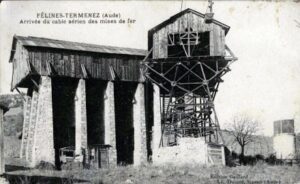The history of mining in the Corbières region, located in southern France, particularly within the Aude department in the Languedoc-Roussillon area, dates back thousands of years and is closely tied to the rich natural resources of this rugged and mountainous terrain.
Prehistoric and Ancient Mining
Mining activity in the Corbières dates back to prehistoric times, with evidence of early human communities extracting various minerals. During the Bronze Age (around 3,000 BCE), people began to extract copper, a key metal for making tools and weapons. The Corbières area has rich deposits of copper and lead, which were crucial during this period.
Later, during the Iron Age, mining activity expanded, and iron ore became an essential resource. The presence of iron-bearing minerals in the Corbières made the region an important site for early metallurgy. Some of the mining operations during these early periods were relatively rudimentary but provided the materials needed for local and regional societies.
Roman Period
During the Roman period (1st century BCE – 5th century CE), mining activities in the Corbières were intensified and organized. The Romans exploited various mineral resources in the area, including gold, silver, lead, and iron. They brought advanced mining techniques, including hydraulic mining, where water was used to wash away debris and expose ore deposits.
Gold mining, in particular, was significant during Roman times. The Romans developed gold mines in the region, such as the one near Salsigne, which would later become one of Europe’s most important gold mines. Roman roads and infrastructure helped transport these valuable minerals to other parts of the empire.
Medieval and Renaissance Mining
After the decline of the Roman Empire, mining in the Corbières region slowed down, though it never ceased entirely. During the Middle Ages (5th – 15th centuries), monasteries and local lords controlled much of the land, and small-scale mining operations continued. However, the scale and intensity of mining were much less than during the Roman period.
In the Renaissance period (15th – 17th centuries), the demand for metals such as iron, lead, and copper grew once again as European economies expanded. The Corbières, being rich in these minerals, saw a revival in mining activity. The region supplied metal for tools, weapons, and building materials during this time.
Modern Era (18th – 20th Century)
The 18th century saw a significant transformation in mining technology and organization in the Corbières. The Industrial Revolution in the 19th century spurred further development of the mining sector. Mining operations became larger and more mechanized.
- Salsigne Mine (Late 19th Century – 20th Century): The Salsigne mine, located near the northern edge of the Corbières, became one of the most famous and important mines in Europe during this period. It was initially developed for gold mining but also produced arsenic and antimony, minerals that were crucial for industry. The Salsigne mine produced gold from the late 19th century until its closure in 2004, making it the largest gold mine in France at its peak. Arsenic production from the mine was also notable, particularly during the world wars when the demand for arsenic surged for use in military applications (e.g., chemical weapons).
- Lead and Iron Mining: The Corbières region continued to produce lead and iron during the 19th and early 20th centuries. Several mines operated in various locations across the region, contributing to the local economy. However, by the mid-20th century, these mining activities began to decline due to resource depletion and competition from other regions.
Decline of Mining in the 20th Century
By the mid-20th century, mining activity in the Corbières began to diminish. Several factors contributed to this decline:
- Depletion of Resources: Many of the easily accessible and high-quality mineral deposits were depleted over centuries of mining.
- Environmental Concerns: As awareness of environmental impacts grew, mining operations faced stricter regulations.
- Economic Shifts: The global economy moved towards other regions with cheaper and more accessible mineral resources.
The Salsigne mine remained operational into the early 21st century, but it eventually closed in 2004 due to a combination of environmental concerns, rising costs, and resource depletion.
Present Day
Today, mining in the Corbières is largely a thing of the past, with the region shifting its focus toward other economic activities such as tourism, wine production, and agriculture. However, the historical legacy of mining is still evident in the landscape, with remnants of old mines, tunnels, and infrastructure scattered across the region.
Environmental issues from past mining, particularly related to arsenic contamination around the Salsigne area, continue to be a concern for local communities and governments.
The history of mining in the Corbières is one of continuity and transformation, spanning from prehistoric times to the modern era. The region’s mineral wealth attracted human activity for millennia, helping shape the local economy and development. While mining has largely ceased, its legacy remains an integral part of the Corbières’ cultural and historical identity.


